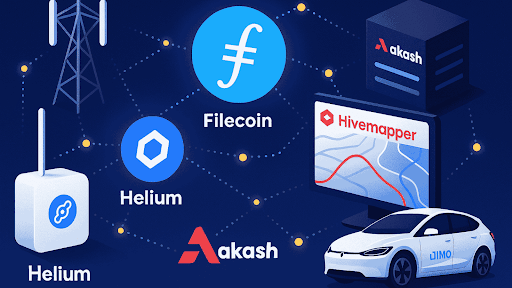- DePIN projects like Helium, Filecoin, Hivemapper, Akash, and DIMO are delivering real-world utility in sectors like IoT, logistics, mapping, and cloud computing.
- By tokenising physical infrastructure and incentivizing deployment, these platforms are redefining ownership and access in infrastructural services.
- 2025 marks the moment DePIN became more than a concept—it became a technical and economic reality.
Decentralized Physical Infrastructure Networks (DePIN) are no longer a niche concept. In 2025, DePIN projects that bridge physical assets and blockchain—such as Helium, Filecoin, and Hivemapper—have proven their utility. This year, adoption has accelerated, as more individuals and enterprises embrace decentralized sensor networks, shared bandwidth, and distributed storage. This article examines the DePIN platforms making tangible impact today.
1. Helium: A New Standard in Decentralized Wireless
Helium has continued its growth as a decentralized IoT network. In 2025, LoRaWAN-powered hotspots now cover thousands of cities worldwide, enabling smart meter reading, environmental monitoring, and asset tracking. What sets Helium apart is its real-world use case: businesses in agriculture use it for soil moisture tracking, while logistics companies rely on it for inland asset visibility. By removing traditional telecom middlemen and rewarding participants with HNT tokens, Helium has built a functioning and expansive wireless ecosystem.
2. Filecoin: Decentralized Storage for the Modern Web
The narrative around Filecoin has matured in 2025. With growing demand for redundant, censorship-resistant storage, Filecoin provides a robust decentralized alternative. Its real-world utility has doubled as enterprises and universities began using FIL-powered nodes for archiving scientific datasets and large media. Partnerships with research institutions and universities have also made Filecoin an essential infrastructure layer for permanent data storage and open-access archives.
3. Hivemapper: Mapping the World, Decentralized
Hivemapper is forging a new frontier in decentralized mapping. Users install dashcams that upload street-level video data directly onto the blockchain. In return, participants receive HONEY tokens while global map coverage is updated by community effort. In 2025, Hivemapper data is being used in logistics planning, insurance risk modeling, and smart city development. Its decentralized approach not only challenges centralized mapping services—it also compensates contributors fairly based on data relevance.
4. Akash Network: Compute as a Service, Decentralized
Decentralized cloud computing has found its champion in Akash Network. In 2025, developers and enterprises are bidding on decentralized compute auctions to deploy applications at reduced cost. Sectors such as scientific computing and AI model training benefit from Akash’s decentralized pricing. By disintermediating cloud providers and using AKT as a clearing token, Akash provides transparent cost, scalable compute, and a novel pay-as-you-go model that is reshaping the infrastructure-as-code landscape.
5. DIMO & io.net: Sensor Networks on Wheels
The combined promise of DePIN platforms like DIMO and io.net is clear: they decentralize vehicle sensor and compute infrastructure. Users can install modules to stream telemetry, environmental, or energy usage data. In return, they earn native tokens while contributing to decentralized AI model training, fleet optimization, and data marketplaces. 2025 has seen pilot programs with logistics firms and fleet operators—offering real-time road condition updates, predictive maintenance alpha, and a visible route to monetising vehicle telemetry data.
Key Drivers Behind DePIN’s Momentum
DePIN’s success in 2025 isn’t just hype—it reflects emerging real-world needs.
Decentralized incentives allow anyone to deploy infrastructure and earn tokens.
Hardware advances in sensors, low-power IoT devices, and 5G technology make deployment practical.
Institutional participation—from agriculture to logistics—drives real demand, validating these networks beyond speculative value.
As industries realign around decentralized infrastructure, DePIN projects are building working products that serve measurable use cases and earnings.
Challenges: Scaling, Regulation, and Interoperability
Growth does not come without hurdles. DePIN players face regulatory scrutiny, especially where data and privacy rules intersect with decentralized sensors. Scaling poses another limitation: network saturation and overcapitalised hotspots can dilute rewards. Finally, interoperability remains a concern. Many DePINs operate in isolation, which slows mainstream integrations. Solving these challenges will be crucial for maintaining DePIN’s upward momentum in the coming years.
What to Monitor Through the Rest of 2025
Helium’s 5G rollout, Filecoin’s enterprise integration, or DIMO’s partnerships will serve as real-world barleyltests for DePIN’s potential. Akash’s node counts and cloud market share, as well as Hivemapper’s licensing deals with municipalities, will also be key variables. Evaluating token utilities, infrastructure deployment, and participating user growth will shed light on DePIN’s long-term viability.
Conclusion: DePIN Goes Mainstream
In 2025, DePIN has transitioned from an intriguing theory to a set of platforms solving real infrastructure problems. Deploying networks of sensors, compute, storage, and connectivity, these projects are redefining ownership and access control. As blockchain reshapes the digital world, DePIN carries that transformation into our physical environment, rewarding early adopters and reframing infrastructure control and monetization.


